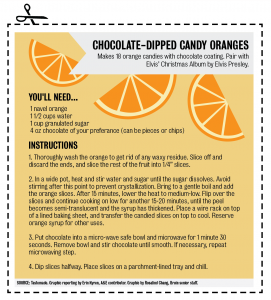The party food landscape has become increasingly homogeneous, with its ubiquitous bag of Doritos rather than homemade fudge or stuffed mushrooms. Columnist Erin Nyren would like to bring back the house parties of yore, in which everyone cooked or baked something to share.
I was never much of a cook before I rented an apartment.
The extent of my cooking was making brownies out of a box or helping my mom with a casserole. Once I got my own apartment and had to start making food for myself, however, I found that cooking was one of the most calming things I’d ever done. Having complete control over everything in the kitchen helps me relax when school gets overwhelming. I dove headfirst into recipe-hunting and pantry-stockpiling and haven’t looked back since.
Since I started cooking, I’m always looking out for new and interesting recipes to try. When I was a kid, my mom would put oranges or tangerines in my stocking at Christmas time. I don’t know what about oranges makes them Christmas-y, because to me they evoke images of Florida and sunny days. Somehow chocolate oranges from Trader Joe’s and clove-studded orange pomanders seem to get mixed in with the gingerbread cookies and eggnog.
When I saw a recipe for chocolate-dipped candy oranges on the Tastemade Facebook page, it reminded me of Christmas and, since the holiday season had arrived, I decided to give it a try.
Most of the time spent on this recipe was waiting for the oranges to candy, a process which saturates the fruit with sugar. The sugar-water solution is called simple syrup, used in many candy-related recipes. It can be saved after the oranges are done candying for use in cocktails as well.
One word of warning: Don’t be lulled into thinking the simple syrup isn’t sticky. Although it’s called “syrup,” its apparent consistency when first made is nothing like maple syrup, whose consistency humans have learned to associate with stickiness. Simple syrup moves just like water, so when it spills on the floor or gets on hands or the countertop, the automatic response is that it’s fine. Trust me, I know from experience, it’s not fine. This stuff is sticky as heck, so don’t forget about the spill or else regret it later.
Now is the time to use a huge pan (12 inches or wider). I candied my oranges in two batches with nine slices each using a smaller pan because I wasn’t thinking about the time involved, but waiting 40 minutes each for two batches became a bit wearing.
Because of all of the waiting involved, this recipe is a good for students who have flash-card-style studying to do. Once the oranges were in the pan, I was free to do whatever for about 40 minutes, coming back once after 20 minutes to flip the the slices.
Something I neglected to mind on my second batch was the heat intensity. If the heat is left on too high for too long, two things will happen. One, a ton of foam will form, which will start to turn a dark orangish-brown as the sugar in the syrup burns. Two, the bottoms of the oranges will blacken a little, which doesn’t affect the taste much, but could be aesthetically displeasing.
After you’ve candied the oranges, melting the chocolate is pretty straightforward once you know how to do it, but I didn’t, and the recipe did not tell me how to do it. Since I was already using the stove, I first tried to melt the chocolate there.
I threw one of the two 65 percent cacao chocolate bars that I had selected from Trader Joe’s – thinking they were the same as the regular dark chocolate that the recipe called for – into a small saucepan and turned the heat on medium-high. I stood next to the pan waiting for the chocolate to show signs of melting before I started stirring when I noticed an extremely unpleasant, pungent smell.
Ten seconds later, I attempted to stir a burned, disgusting mess that, upon further inspection, tasted horrible. I tried the unused 65 percent bar and realized that although the first chocolate bar had definitely burned, the high cacao percentage hadn’t helped its flavor either.
In short, I recommend microwaving semi-sweet chocolate. The microwave melts the chocolate more slowly without much effort, and semi-sweet chocolate tastes much better with the oranges than bitter chocolate does.
I divided the oranges into little goodie bags, and gifted them to my friends along with some sugared cranberries. They all remarked on one thing: The oranges tended to glue their teeth together a little. Personally, I didn’t have a problem with the chewiness, especially since some slices seemed to be more sticky than others, but if you don’t care for chewy candy, this might not be for you.
Although my oranges came out deliciously, I decided that with the long wait involved, I wouldn’t want to have to make more than about 20 unless I bought a larger pan. Nevertheless, I had a delectable adventure in candying using only a few common household ingredients.
– Erin Nyren
What’s the best food you’ve ever eaten at a party? Email Nyren at enyren@media.ucla.edu!

